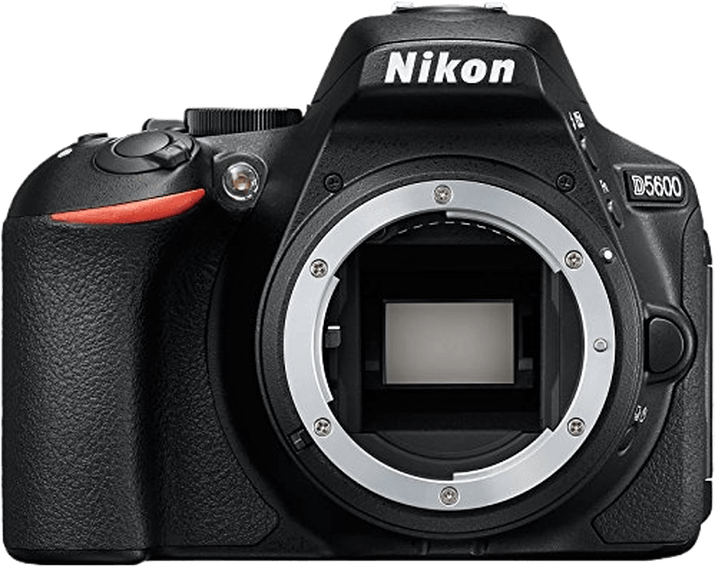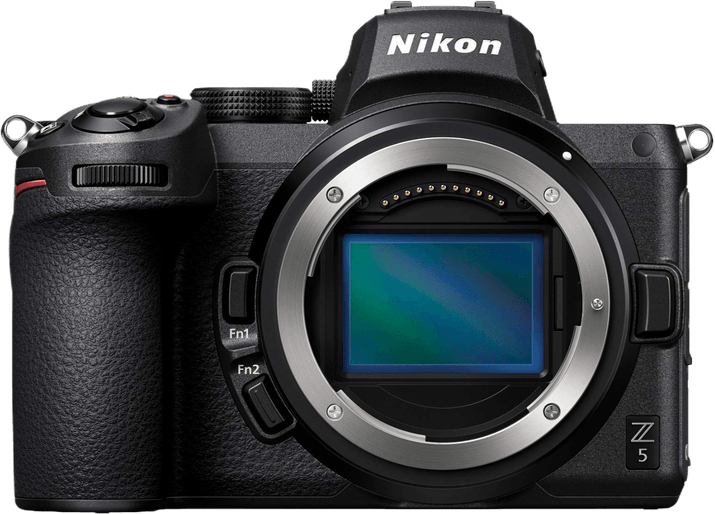Nikon D5600 vs Z5 Comparison
Nikon D5600

Nikon Z5

The Nikon Z5, with a score of 78 out of 100, outperforms the Nikon D5600, which has a score of 66. Both cameras share similarities such as being produced by Nikon and having similar dimensions. However, there are key differences that set them apart.
The Nikon Z5, a mirrorless camera released in 2020, is superior due to its more advanced technology and higher score. Its launch price of $1400 reflects its higher quality and performance. Additionally, the Nikon Z5 is slightly larger and heavier at 134 x 100.5 x 69.5mm and 675g compared to the D5600’s 124 x 97 x 70mm and 465g.
On the other hand, the Nikon D5600, a DSLR camera launched in 2016, has a lower score and a more affordable launch price of $700. Its smaller size and lighter weight make it more portable. Despite its lower score, it still offers reliable performance for its price range.
Taking these factors into account, the Nikon Z5 stands out as the better option for those seeking advanced technology and higher performance, while the Nikon D5600 remains a solid choice for budget-conscious buyers prioritizing portability.
Nikon D5600 vs Z5 Overview and Optics
The Nikon Z5 takes the lead in optics with a score of 81/100, outperforming the Nikon D5600, which scores 65/100. Both cameras share similarities in specifications, such as having CMOS sensors and 24-megapixel resolutions. However, there are distinct differences that set them apart and contribute to the Z5’s higher score.
The Nikon Z5’s superiority in optics can be attributed to its full-frame sensor, Expeed 6 processor, and image stabilization. Its full-frame sensor provides better image quality and low-light performance compared to the D5600’s APS-C sensor. The Expeed 6 processor ensures faster image processing and better overall performance. Moreover, the Z5’s image stabilization allows for sharper images even in challenging shooting conditions. The Z5 also has a higher DXOMARK score of 97, reflecting its better sensor performance.
On the other hand, the Nikon D5600 has a slightly faster shooting speed of 5 compared to the Z5’s 4.5. This advantage might be useful in certain situations, such as sports or wildlife photography, where capturing fast-moving subjects is essential. Additionally, the D5600 uses the Nikon F DX lens mount, which provides a wider range of compatible lenses, whereas the Z5 uses the newer Nikon Z mount with a more limited selection of lenses.
Taking these factors into consideration, the Nikon Z5 is the clear winner in terms of optics. Its full-frame sensor, Expeed 6 processor, and image stabilization make it a more capable camera for producing high-quality images. The Nikon D5600, while having a slight advantage in shooting speed and lens compatibility, falls short in delivering the same level of optical performance as the Z5.
Nikon D5600 vs Z5 Video Performance
The Nikon Z5 emerges as the superior camera in terms of video capabilities, boasting a video score of 83/100, compared to the Nikon D5600’s 70/100. Both cameras share some common specifications, such as a maximum video frame rate of 60fps and built-in time-lapse functionality. However, the Nikon Z5 outshines the D5600 in certain aspects, making it the better choice for video recording.
A key advantage of the Nikon Z5 is its 4K video resolution, providing a maximum video dimension of 3840 x 2160. This feature results in higher quality footage with greater detail and clarity. In contrast, the Nikon D5600’s maximum video resolution is Full HD, with dimensions of 1920 x 1080. This difference in resolution significantly contributes to the Z5’s higher video score.
While the Nikon D5600 falls short in resolution, it does offer some advantages. Its lower video resolution requires less storage space, making it more suitable for users with limited storage capacity. Additionally, the D5600’s Full HD resolution may suffice for casual users or those who do not require the highest video quality.
Taking these factors into consideration, the Nikon Z5 proves to be the superior choice for video recording due to its 4K resolution and higher video score. Meanwhile, the Nikon D5600 may be suitable for those with storage constraints or casual users who do not require top-tier video quality. Ultimately, the decision between these two cameras depends on the specific needs and priorities of the user.
Nikon D5600 vs Z5 Features and Benefits
The Nikon D5600 and Nikon Z5 both have a feature score of 72 out of 100. These cameras share several specifications, making them comparable in terms of features. Both cameras have a 3.2-inch screen, touchscreen capabilities, flip screen, GPS, WIFI, and Bluetooth connectivity.
The Nikon Z5 has a slightly higher screen resolution at 1,040,000 dots compared to the D5600’s 1,037,000 dots. This higher resolution provides a clearer and sharper image when reviewing photos and videos. The Z5 also has a full-frame sensor, which offers better image quality, especially in low-light situations, and a wider dynamic range.
On the other hand, the Nikon D5600 has a smaller and lighter body, making it more portable and easier to carry around for extended periods. The D5600 also has a longer battery life, allowing for more shots to be taken before needing to recharge or replace the battery.
Both cameras offer excellent features, and the choice between them depends on individual preferences and priorities. The Nikon Z5 is the better choice for those who prioritize image quality and a higher screen resolution. Meanwhile, the Nikon D5600 is a more suitable option for those who value portability and longer battery life.
Considering the shared feature score and the individual advantages of each camera, both the Nikon D5600 and Nikon Z5 are great options for photography enthusiasts. The choice ultimately depends on the specific needs and preferences of the user.
Nikon D5600 vs Z5 Storage and Battery
The Nikon Z5 outperforms the Nikon D5600 in storage and battery with a score of 73/100 compared to 43/100. Both cameras accept SD, SDHC, and SDXC memory cards. However, the Z5 has two memory card slots and supports faster UHS-II cards, while the D5600 has only one slot and is limited to UHS-I compatibility. This makes the Z5 more versatile and efficient in handling larger files and faster write speeds.
Regarding battery, the D5600 offers a longer battery life of 970 shots, compared to the Z5’s 470 shots. Despite this advantage, the Z5 uses the EN-EL15c battery, which supports USB charging. This feature allows for convenient charging options and continuous use in various situations. On the other hand, the D5600 uses the EN-EL14a battery and lacks USB charging capabilities.
Considering these factors, the Nikon Z5 offers better storage options and flexible charging, making it the superior choice in this category. The Nikon D5600, while having a longer battery life, falls short in other aspects and may not be as suitable for professional or demanding photography needs.
Nikon D5600 vs Z5 – Our Verdict
Are you still undecided about which camera is right for you? Have a look at these popular comparisons that feature the Nikon D5600 or the Nikon Z5:

